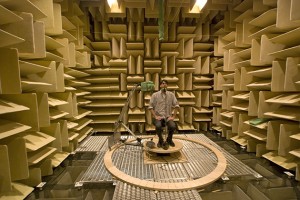Researchers at University of Connecticut Health Center, the University of Rochester, and University of Louisville have published a paper in the Journal of Neuroscience, investigating the ability of a rabbits to determine the distance of a noise source depends on the modulation of the sound. The researchers inserted tiny microphones inside rabbits’ ears to record the sounds played at several locations. They used these recordings to simulate modulated or unmodulated noise coming from different distances away from the rabbit. Then they played the simulated sounds back to the rabbit, and measured the responses of neurons in the rabbit’s inferior colliculus (IC), a region of the midbrain known to be important for sound perception. When the rabbit heard the simulated sounds, certain types of IC neurons fired more when the sound was closer and the depth of modulation was higher – that is, when there was a bigger difference between the sound’s maximum and minimum amplitude. The neurons fired less when the sound source was further away.
Read the full article on the UConn Today web site.
